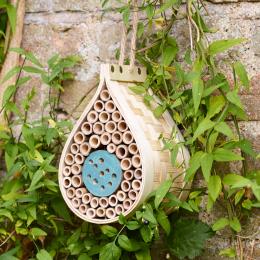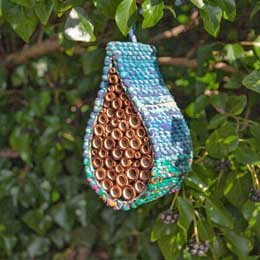Slide 1 of 1 



No-quibble free returns:
Unhappy with your item? We offer no-quibble free returns
Nature-friendly products:
Sourced through ethical and sustainable accreditations
Free delivery over £40:
£3.95 standard UK shipping, or free shipping over £40
Supporting the RSPB:
Every purchase you make supports wildlife
Insect & minibeast centres
Insects and minibeasts are valuable friends of our gardens. They are not only an important source of food for other animals, but essential to pollinate our flowering plants and crops, giving us nutrient-rich soil. Our range of insect and minibeast hotels provide cosy and safe shelters for them to call home in the Summer months, and hibernate during the cold Winter months
2 list items
Bug hotel FAQ
What is a bug hotel?
A bug hotel is a structure designed to provide shelter and nesting opportunities for a variety of beneficial insects and other small creatures. You can expect to find bees and butterflies, woodlice, ladybirds, spiders, snails and more inside a bug hotel, especially in autumn & winter when they’re looking for somewhere safe and cosy to hibernate.
Why are bug hotels important?
Many of our native insect species are struggling to find sufficient homes and food sources in the UK. Bug hotels can provide food for some invertebrates and shelter for others, helping them survive and thrive. Having more of these beneficial insects in our gardens may also help in managing unwanted garden pests that wreak havoc on our plants and vegetable patches.
Where to place a bug hotel
Where you place a bug hotel will be dependent on your garden, and what types of insects you’re hoping to attract. Many bugs such as woodlice, earwigs and beetles prefer darker, damp conditions, while bees and butterflies prefer drier, sunnier spots. You may have to try out a few spots to find the best one and make sure it’s protected from the elements and potential predators, then check back after a week or so and if you don’t have any house guests yet, try another spot.
Do bug hotels need cleaning?
Bug hotels will benefit from the occasional clean to remove built-up nesting materials and other organic matter that can accumulate over time.
The best time to clean a bug hotel is in late winter/early spring when insect activity is usually at its lowest.
Put on a pair of protective gloves and a mask before gently opening each compartment and removing debris. Use a small brush or stick to dislodge any stubborn materials, avoiding sections that are still being lived in. Only use hot soapy water, never bleach or disinfectant, and allow it to dry thoroughly.
Can you paint a bug hotel?
If you would like to paint your bug hotel, it’s imperative to use paints that are water-based and non-toxic. Keep in mind that insects are attracted to natural materials and scents, so it’s a good idea to choose a finish that preserves the natural look and feel of wood. Some strong scents can also deter insects. Make sure that any paint or wood stain you use is completely dry before setting up your bug hotel ready for visitors.

